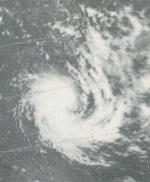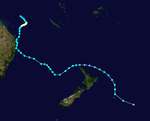| 1973–74 South Pacific cyclone season | |
|---|---|
 Season summary map | |
| Seasonal boundaries | |
| First system formed | November 7, 1973 |
| Last system dissipated | April 28, 1974 |
| Strongest storm | |
| Name | Pam |
| • Maximum winds | 195 km/h (120 mph) (10-minute sustained) |
| • Lowest pressure | 925 hPa ( mbar) |
| Seasonal statistics | |
| Total disturbances | 10 |
| Tropical cyclones | 10 |
| Severe tropical cyclones | 2 |
| Total fatalities | Unknown |
| Total damage | Unknown |
| Related articles | |
The 1973–74 South Pacific cyclone season was an inactive season. In tropical cyclones, it was an average season, but in strength, it was very inactive, with only two severe tropical cyclones.
Systems
Tropical Cyclone SP7301
| Category 1 tropical cyclone (Australian scale) | |
| Tropical storm (SSHWS) | |
| Duration | November 7 – November 11 |
|---|---|
| Peak intensity | 65 km/h (40 mph) (10-min); 990 hPa ( mbar) |
Severe Tropical Cyclone Natalie–Lottie
| Category 3 severe tropical cyclone (Australian scale) | |
| Category 1 tropical cyclone (SSHWS) | |
| Duration | December 1 – December 11 |
|---|---|
| Peak intensity | 120 km/h (75 mph) (10-min); 965 hPa ( mbar) |
This storm initially formed as Natalie, then moved into the Australian region on the same day. Later, it moved back into the South Pacific and was renamed Lottie. [1] High seas caused the ship Uluilakeba to capsize killing more than 85 people. [2] [3] This makes Lottie one of the deadliest tropical cyclones in region in recent decades. [4]
Tropical Cyclone Monica
| Category 1 tropical cyclone (Australian scale) | |
| Tropical storm (SSHWS) | |
| Duration | January 15 – January 20 |
|---|---|
| Peak intensity | 65 km/h (40 mph) (10-min); 990 hPa ( mbar) |
Tropical Cyclone Nessie
| Category 1 tropical cyclone (Australian scale) | |
| Tropical storm (SSHWS) | |
| Duration | January 17 – January 22 |
|---|---|
| Peak intensity | 65 km/h (40 mph) (10-min); 990 hPa ( mbar) |
Tropical Cyclone Vera
| Category 2 tropical cyclone (Australian scale) | |
| Tropical storm (SSHWS) | |
| Duration | January 21 – January 22 |
|---|---|
| Peak intensity | 95 km/h (60 mph) (10-min); 985 hPa ( mbar) |
Severe Tropical Cyclone Pam
| Category 4 severe tropical cyclone (Australian scale) | |
| Duration | January 30 – February 8 |
|---|---|
| Peak intensity | 195 km/h (120 mph) (10-min); 925 hPa ( mbar) |
Tropical Cyclone Rebecca
| Category 1 tropical cyclone (Australian scale) | |
| Duration | February 19 – February 28 |
|---|---|
| Peak intensity | 75 km/h (45 mph) (10-min); 988 hPa ( mbar) |
Rebecca was thought to have had a complex evolution with two low-level circulation centres. [5] It had peak 10-minute sustained windspeeds of 75 km/h (45 mph) and a minimum pressure of 988 hPa (29.18 inHg), before it dissipated during February 28. [5]
Tropical Cyclone Zoe
| Category 2 tropical cyclone (Australian scale) | |
| Tropical storm (SSHWS) | |
| Duration | March 14 – March 20 |
|---|---|
| Peak intensity | 100 km/h (65 mph) (10-min); 980 hPa ( mbar) |
Tropical Cyclone Alice
| Category 2 tropical cyclone (Australian scale) | |
| Tropical storm (SSHWS) | |
| Duration | March 23 – March 30 |
|---|---|
| Peak intensity | 100 km/h (65 mph) (10-min); 980 hPa ( mbar) |
Tropical Cyclone Tina
| Category 2 tropical cyclone (Australian scale) | |
| Tropical storm (SSHWS) | |
| Duration | April 23 – April 28 |
|---|---|
| Peak intensity | 100 km/h (65 mph) (10-min); 980 hPa ( mbar) |
Seasonal effects
| Name | Dates | Peak intensity | Areas affected | Damage ( USD) |
Deaths | Refs | ||
|---|---|---|---|---|---|---|---|---|
| Category | Wind speed | Pressure | ||||||
| SP7301 | November 7 – 11 | Category 1 tropical cyclone | 65 km/h (40 mph) | 990 hPa (29.23 inHg) | ||||
| Natalie-Lottie | December 1 – 11 | Category 3 severe tropical cyclone | 120 km/h (75 mph) | 965 hPa (28.50 inHg) | ||||
| Monica | January 15 – 20 | Category 1 tropical cyclone | 65 km/h (40 mph) | 990 hPa (29.23 inHg) | ||||
| Nessie | January 17 – 22 | Category 1 tropical cyclone | 65 km/h (40 mph) | 990 hPa (29.23 inHg) | ||||
| Vera | January 21 – 22 | Category 2 tropical cyclone | 100 km/h (65 mph) | 980 hPa (28.94 inHg) | ||||
| Pam | January 30 – February 8 | Category 4 severe tropical cyclone | 195 km/h (120 mph) | 925 hPa (27.32 inHg) | ||||
| Rebecca | February 19 – 28 | Category 1 tropical cyclone | 75 km/h (45 mph) | 988 hPa (29.18 inHg) | [5] | |||
| Zoe | March 14 – 20 | Category 2 tropical cyclone | 100 km/h (65 mph) | 980 hPa (28.94 inHg) | ||||
| Alice | March 23 – 30 | Category 2 tropical cyclone | 100 km/h (65 mph) | 980 hPa (28.94 inHg) | ||||
| Tina | April 23 – 28 | Category 2 tropical cyclone | 100 km/h (65 mph) | 980 hPa (28.94 inHg) | ||||
| Season aggregates | ||||||||
| 8 systems | October 19 – April 6 | 155 km/h (100 mph) | 945 hPa (27.91 inHg) | |||||
See also
- Atlantic hurricane seasons: 1973, 1974
- Eastern Pacific hurricane seasons: 1973, 1974
- Western Pacific typhoon seasons: 1973, 1974
- North Indian Ocean cyclone seasons: 1973, 1974
References
- ^ "Tropical Cyclone Natalie-Lottie track map". Australia Severe Weather.com. Retrieved 2009-07-05.
-
^ Raicola, Verenaisi (27 March 2007).
"Beware the force of nature". The Fiji Times Online. Archived from
the original on 8 May 2014. Retrieved 6 March 2023.
Perhaps the most tragic of all was the Uluilakeba, which capsized in southern Lau during Cyclone Lottie on December 10, 1973. More than 50 people died in that sea disaster.
-
^ Kalougata, Joeli (October 2004).
"The Only Survivor". LDS.org. Archived from
the original on 16 March 2008. Retrieved 6 March 2023.
Of the approximately 120 passengers who had boarded the doomed ship, 35 were found alive in the water. We were taken to Suva and admitted to the hospital. There, I learned the details of what had happened. Less than four hours after leaving the dock, we had been struck by Cyclone Lottie, a short-lived Pacific storm.
- ^ "Cyclone (Daman) spared populated parts of Fiji". Associated Press. December 10, 2007. Archived from the original on December 7, 2007. Retrieved 2009-07-05.
- ^ a b c "Saison des perturbations tropicales: 1973-1974 dans le pacifique sud-oues". Météorologie Maritime (in French). No. 137. 1976. pp. 49–51. ISSN 2107-0830.













